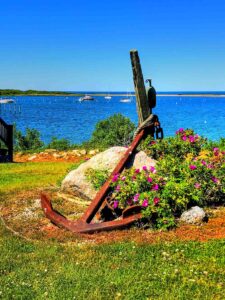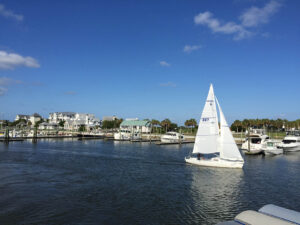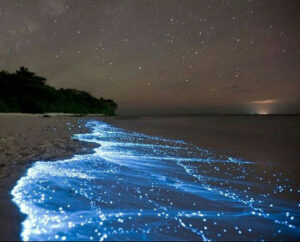FORTY YEARS AGO, the phrase “beautiful Mexican beach” automatically called to mind the country’s Pacific coast — Acapulco, Mazatlán, Puerto Vallarta — rather than the tiny undeveloped coastal towns on the fringe of the Yucatan jungle.
What a difference a few decades make. Now, the east coast resorts of Cancún, Cozumel and Playa del Carmen and their vast expanses of beach along the Riviera Maya dwarf the Pacific playas and their relatively modest sands. But you can still find places along Mexico’s east coast to get away from it all and enjoy clear Caribbean waters.
These seven secluded Mexico beaches are worth checking out, two north of Cancún, and the others south of the mega-resort strip, on Mexico’s East Coast.
North of Cancún
ISLA HOLBOX
Just off the northern tip of the Yucatan Peninsula lies Isla Holbox, a narrow strip of land that’s part of the Yum Balam Nature Reserve. Out on the western end of the island is the tiny fishing village of Holbox and its white sand beach. If it feels like you’ve reached the ends of the earth, that’s because you pretty much have.
Holbox is about as laid back as you can get … unpaved streets, golf carts instead of cars, a handful of shops and restaurants, a couple of hotels. That’s it. The water is shallow right off the beach, only about waist-high at its deepest, so it’s a great place for families with smaller children. And if you visit between mid-May and mid-September, you might get to swim with the whale sharks — definitely a once-in-a-lifetime experience.
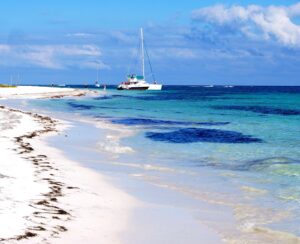
ISLA BLANCA
The peninsula of Isla Blanca extends north from Cancún, the perfect place to escape the tourists and traffic that clog the Riviera Maya mega-resorts. In the middle of the peninsula at its narrowest point, you’ll find Isla Blanca Beach, sitting right where the Gulf of Mexico meets the Caribbean Sea.
Breezes from the east and shallowness of the lagoon make this a popular spot with kiteboarders — a couple of kiteboarding schools are open if you feel like a quick lesson. Hungry? Try La Mojarra or Isla Blanca for some of the freshest seafood imaginable. Then stretch out on the secluded beach and let the sun and surf do their thing.
South of Playa del Carmen
XPU HA
About 30 kilometers south of Playa del Carmen, Xpu Ha offers visitors the laid-back charm, white sands and turquoise waters that define the quintessential Mexican beach. You’ll usually find more locals than tourists here as Xpu Ha is a well-kept secret that has so far avoided the commercialization of its neighbors to the north.
It’s the perfect place for anyone who loves snorkeling, swimming, kayaking, parasailing, fishing or just relaxing in a hammock or beach chair. Ready for lunch? Grab a cold beer and some local seafood at one of the nearby beach bars. Throw in a few beachfront hotels and a handful of casual restaurants, and you’ve got your own little slice of paradise.
AKUMAL
Travel 16 kilometers down the coast and you’ll find yourself at Akumal. Well known as a haven for sea turtles — green, loggerhead and hawksbill. Akumal Bay is also a prime snorkeling destination. According to the website Loco Gringo, “A wide stretch of Akumal’s gorgeous beaches encompasses ‘Las Bahias de Akumal’ — a series of five bays starting to the south of Yal-Ku Lagoon with North Akumal Beach and ending at Aventuras Akumal to the south.”
About a dozen small resorts are scattered along this scalloped stretch of coast, and Lol-Ha at the Hotel Akumal Caribe is a beloved dining spot for a seaside breakfast or dinner. At lunchtime, try the Pizzeria. Visitors not staying at one of the resorts on Akumal Bay are charged an entrance fee of 100 pesos to get to the beach area — a small price to pay for this kind of beauty and tranquility.
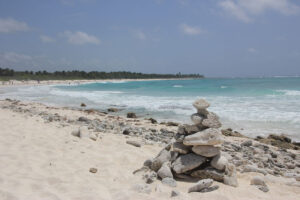
XCACEL
Locally known as Xcacel Área Natural Protegida Estatal, this nature preserve boasts one of the more beautiful, remote beaches on the coast. It’s also a prime sea turtle hatchery and sanctuary, releasing around 200,000 hatchlings each year. Respect for nature is paramount here, and the pristine beauty of the place reflects that.
A half-dozen small hotels across from the entrance to the park offer lodging for long stays, and in the tiny village of Ciudad Chemuyil up the road you’ll find a few rustic restaurants worth checking out, as well as a small supermarket. The charcoal chicken at the modest, friendly Pollo Aplanado de Félix is first-rate.
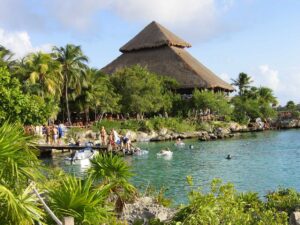
XEL-HÁ
The ruins at Xel-Há date from the 1st century, when it was one of several key ports of the Mayan city of Coba, about 50 kilometers inland. Although a small, rocky beach to the north is lovely, the attraction here is the vast lagoon that empties directly into the Caribbean. Now known as Xel-Há Park, the inlet and the surrounding mangroves, rivers, cenotes and jungle trails are billed as a “commercial aquatic theme park and ecotourism development.”
Even though the main emphasis is on maintaining the area’s natural beauty and ecological purity, you’ll find the requisite water slides, zip lines and other modern attractions. But don’t let that deter you. The inlet of Xel-Há has been called a “natural aquarium” where swimmers encounter hundreds of species of tropical fish and other marine life. Also a turtle preserve and marine research center are fun activities, as well as snorkeling, scuba diving and swimming with dolphins.
The park has four restaurants, and the Zona Arqueologica Xel-Há (the ruins of the historic Mayan port) is located across from the park entrance. Xel-Há Park is open year-round. Admission prices vary depending on what package you select; ticket prices start at $89.99 USD for adults if purchased in advance on the park’s website.
TULUM
The Mayan ruins at Tulum are a must-see for anyone interested in pre-Columbian history and culture. Their growing popularity has helped fuel a building boom in the region, which means that once-secluded Tulum beaches like Playa Santa Fe, Playa Tulum and Playa Paraíso are more crowded these days. Still, their rustic beauty makes them worth a visit.
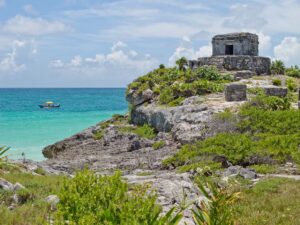
As with anything, it’s all about timing. If you plan to be here in-season (December to April), get to the beach early in the day and save the ruins for later in the afternoon. In May or November (the beginning and end of the rainy season), the beaches are less crowded. Snorkeling and scuba diving are big here (Tulum boasts the second- largest barrier reef in the world), but just lying on the beach is a popular option, too.
When you’re looking for food and drink, plenty of beach clubs, bars and restaurants are within walking distance — dozens more if you rent a bike and venture into Tulum proper. Standout eateries in town include Pollo Bronco, CrisPac, La Negra Tomasa and Xiximak. Note that the beach clubs charge a fee for chairs and towels, so you can save money by bringing your own.
Editor’s Note: 2018 and 2019 saw many of Mexico’s East Coast Caribbean beaches invaded by sargassum seaweed. Clean-up crews have been working overtime, and it’s improved considerably in 2020. Nonetheless, it pays to do research on which beaches are seaweed-free, as conditions can change with the tides and weather. Go to mexicanist.com/l/cancun-seaweed-sargassum/ for info.



